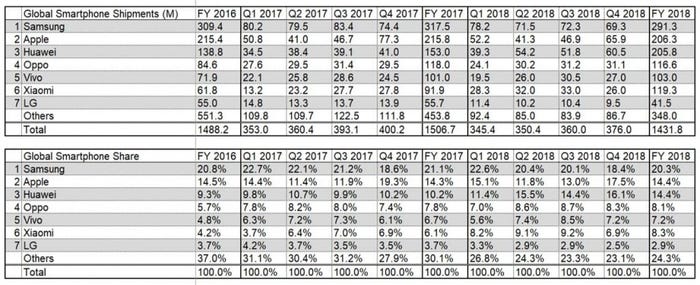Full-year global smartphone market declines for the first time
For five consecutive quarters the global smartphone market has registered year-on-year decline, marking the first time the it has shrunk on annual basis since the first iPhone defined the category in 2007.
January 31, 2019

For five consecutive quarters the global smartphone market has registered year-on-year decline, marking the first time it has shrunk on annual basis since the first iPhone defined the category in 2007.
The size of the contraction is believed to be around 4-5%, according to some research firms. Among the leading smartphone makers, Huawei was the only one that has bucked the trend by increasing its sales volume and vastly improving its market share. By some estimate it is almost neck and neck with Apple.
“Huawei grew 35 percent and shipped a record 205.8 million smartphones globally in full-year 2018,” said Woody Oh, Director at Strategy Analytics. “Huawei is now just a whisker behind Apple, who shipped 206.3 million iPhones last year. Huawei is massively outgrowing the iPhone and we expect Huawei to overtake Apple on a full-year basis worldwide for the first time in 2019.”
In general, the leading Chinese brands, including OPPO, vivo, and Xiaomi (in addition to Huawei) have been aggressively expanding overseas to compensate the weak domestic market. According to the estimates by Counterpoint Research, 46% of the Chinese brands’ total volume was shipped outside of China, up from 33% a year ago. “The collective smartphone shipment growth of emerging markets such as India, Indonesia, Vietnam, Russia and others was not enough to offset the decline in China, which was responsible for almost 1/3 of global smartphone shipments in 2018. With China showing little or no sign of recovery due to various politico-economic factors, Chinese brands are looking to expand overseas,” said Shobhit Srivastava, an analyst from Counterpoint. “To increase market share, Chinese brands have been aggressive in both hardware/software design and marketing.”
Despite being badly hit in the smartphone market in 2018 (and foreseeing continued difficulties in 2019), Samsung was still able to hold on to the overall market leader position. “Samsung shipped 69.3 million smartphones worldwide in Q4 2018, dipping 7 percent annually from 74.4 million units in Q4 2017. Samsung remains the world’s number one smartphone vendor, despite intense competition from Apple, Huawei and others across core markets of India, Europe and the US,” commented Neil Mawston, Executive Director at Strategy Analytics.
Calculating Q4 was made further complicated as this was the first quarter that Apple would not publish the iPhone shipment volume (though it continues to publish iPhone revenues). We sampled three research firms’ published numbers on the market size and vendor share, each of them making their judgement call on Apple as well as other firms that do not publish their shipments.
Both Counterpoint Research and Strategy Analytics believed Apple sold 66 million iPhones in the final quarter of 2018, presumably by applying the announced year-on-year 15% decline of iPhone revenues directly on the volume. This is a crude methodology, as it would assume the average selling price (ASP) of the iPhones has remained constant from a year ago. The new models released in 2018 were sold at much higher price points than their predecessors from 2017. To couple this with Apple’s decision to discontinue some older, cheaper models, the iPhone ASP should only go up, which means its volume decline should be bigger than 15%, though by how much is anyone’s guess.
On the other hand, Canalys estimated that 71.7 million iPhones were sold in Q4, or a 7% decline from Q4 2017. As a matter of fact, the firm, based on this estimate, declared that Apple overtook Samsung to be the market leader in Q4. This calculation implies Apple must have vastly discounted the iPhones to drive up volume. This is not entirely impossible, but it has not been reported broadly.

About the Author
You May Also Like












_1.jpg?width=300&auto=webp&quality=80&disable=upscale)
